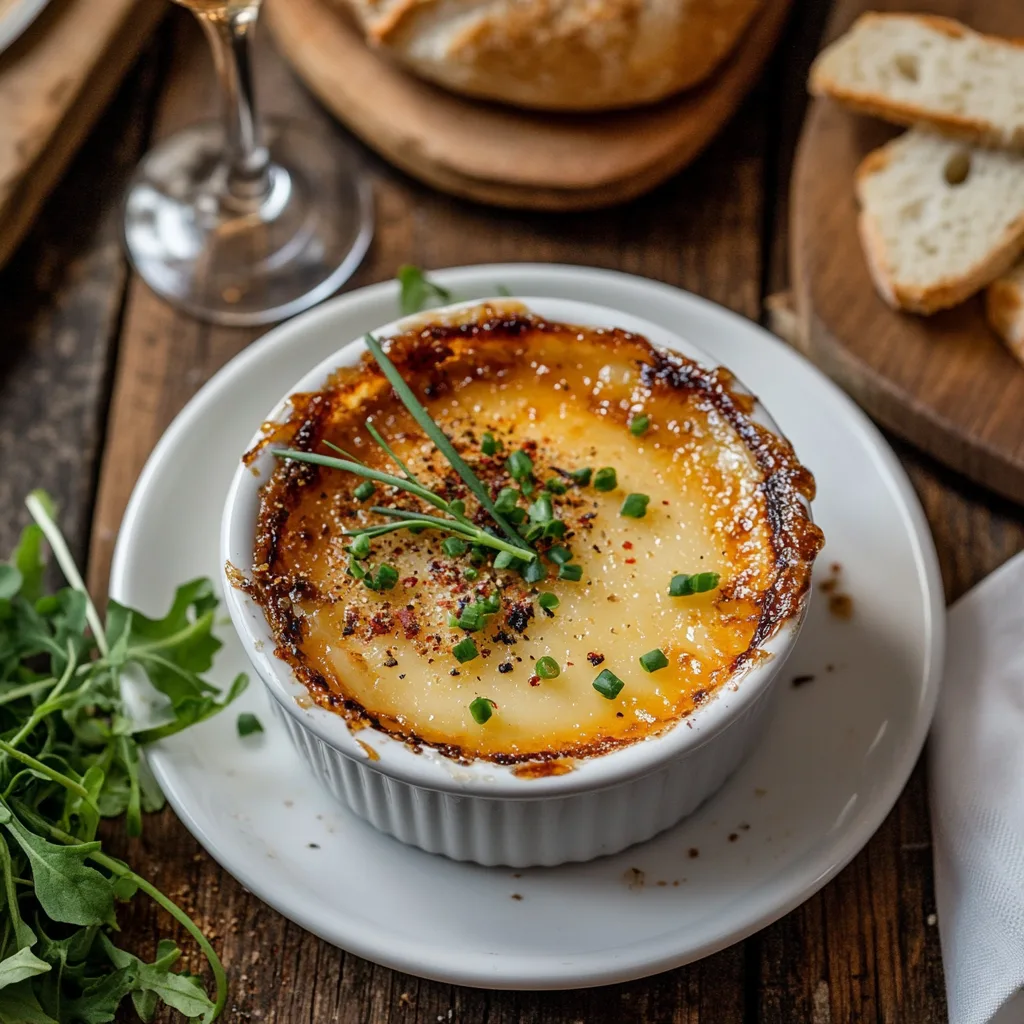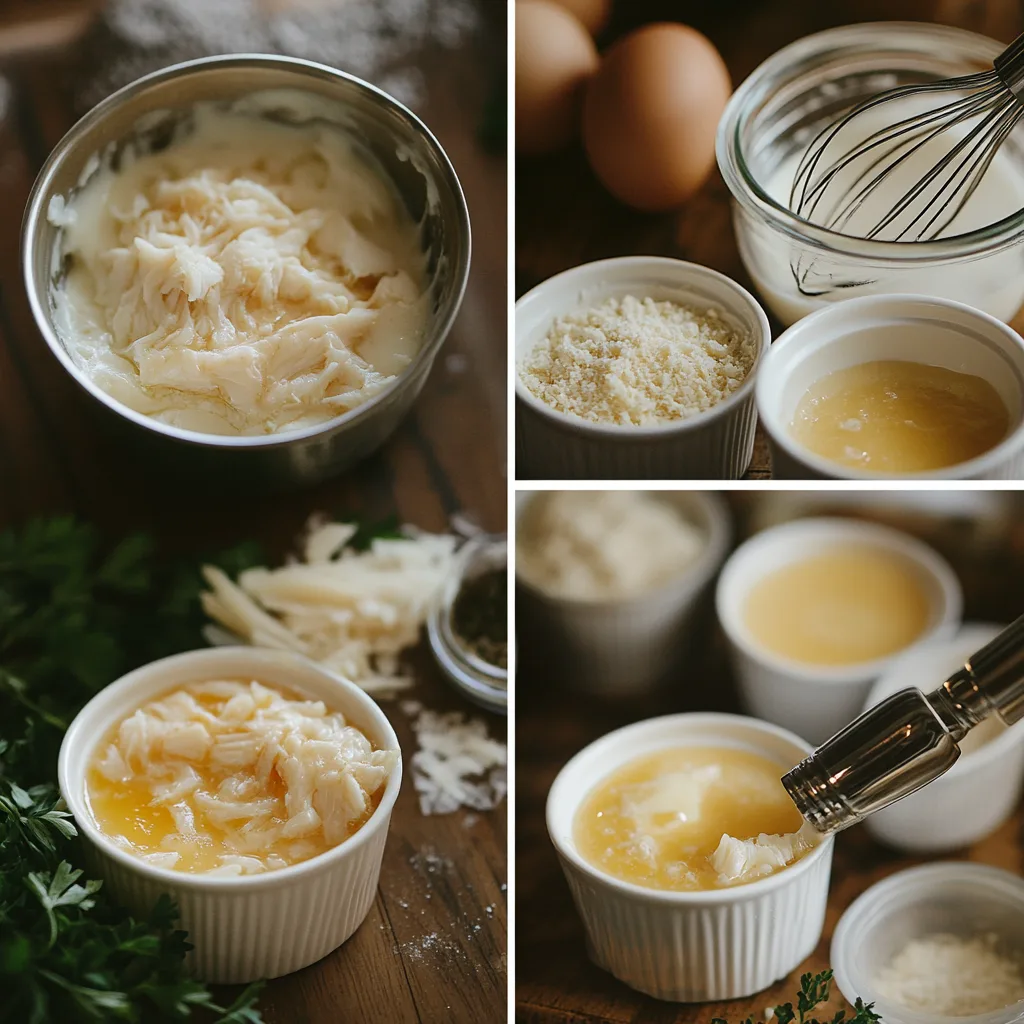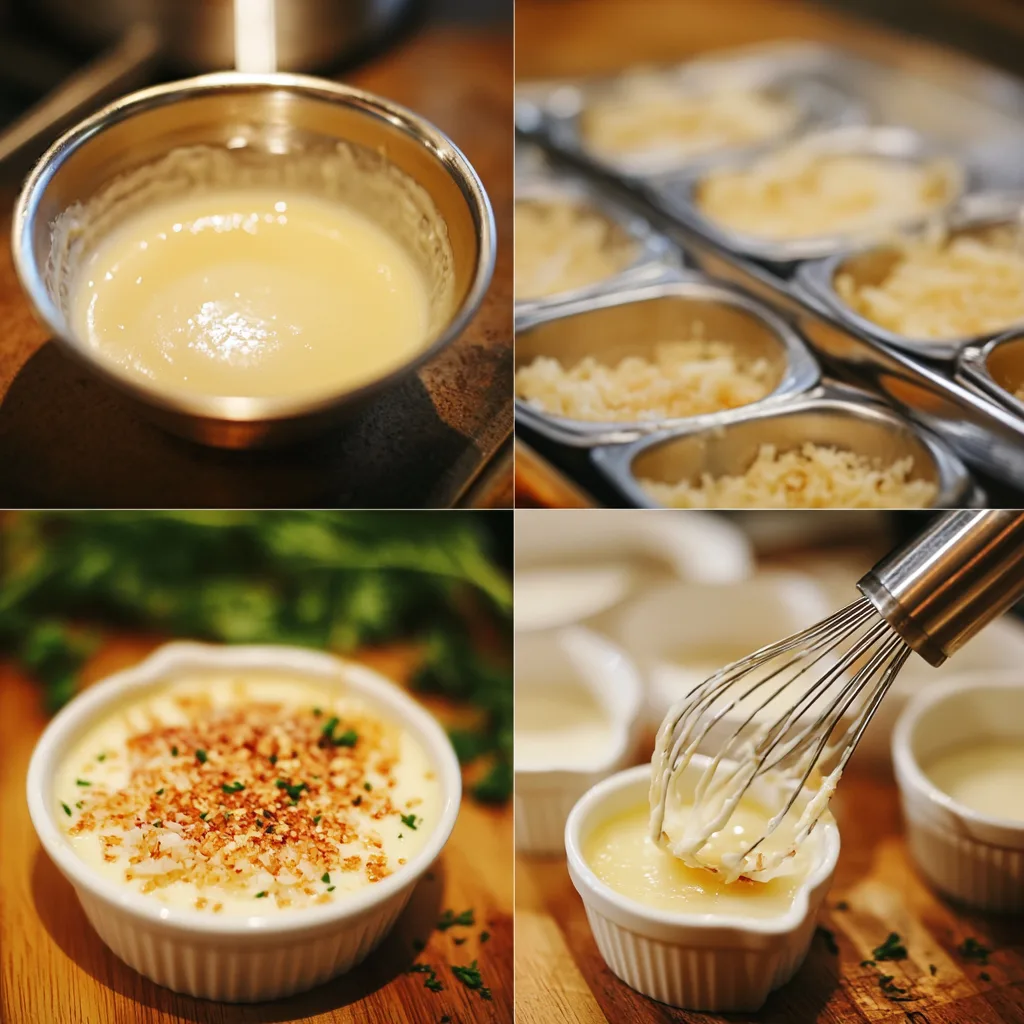
Crab Brulee Recipe may sound unusual at first, but this elegant fusion of creamy seafood and caramelized crust is capturing the attention of food lovers everywhere. Think of it as a bold crossover between a savory appetizer and a rich dessert—creamy crab filling meets a golden, crispy sugar top. This gourmet dish isn’t just about novelty—it’s about texture, contrast, and depth of flavor.
In this article, you’ll discover how to master the Crab Brulee Recipe from scratch. We’ll break down the essential ingredients, step-by-step preparation, culinary science behind the crust, expert cooking tips, unique variations, and FAQs. Whether you’re an adventurous home chef or planning your next dinner party showstopper, this guide has you covered.
Discover great ideas like this crab brulee inspiration on Tasty Meal Recipes, and follow along to create your own showstopping dish.
Introduction to Crab Brulee
What is Crab Brulee and Why It’s Trending
Crab Brulee is an inventive twist on the classic crème brûlée, swapping out the sugary custard for a rich crab-based filling. Instead of serving it at the end of a meal, it opens one—usually as a lavish appetizer or tasting-menu highlight. The key difference lies in its base: instead of sweet cream and vanilla, you get lump crab meat, heavy cream, and subtle spices to balance the flavor.
Originating from a desire to innovate with textures, chefs have begun introducing savory brûlées to challenge the boundaries of traditional cuisine. The crispy burnt sugar top remains, but what’s underneath is a luxurious crab custard, often baked in ramekins and served warm with crostini.
How It Combines Sweet and Savory Flavors
This dish thrives on contrast. The sweetness from the caramelized sugar crust complements the natural brininess of fresh crab. This interplay of sweet and savory elevates the umami profile of the dish, providing a sensory surprise at first bite.
The smooth, almost velvety crab filling contrasts beautifully with the hard, crackable top—a texture made famous by crème brûlée. It’s this multi-layered experience that sets the Crab Brulee Recipe apart, making it a hit among culinary trendsetters and Michelin-style chefs alike.
You don’t need to be a professional chef to pull this off. With the right techniques and fresh ingredients, you can recreate restaurant-quality crab brulee right in your kitchen.
Ingredients Needed for Crab Brulee Recipe
Premium Ingredients for the Best Crab Brulee
The foundation of a successful crab brulee recipe lies in quality ingredients. Since this dish spotlights delicate seafood flavor and texture, even slight variations can dramatically impact the final result. Here’s a breakdown of the premium essentials:
| Ingredient | Description | Recommended Option |
|---|---|---|
| Lump Crab Meat | The star ingredient—sweet, flaky, and soft. Avoid imitation crab. | Fresh jumbo lump or backfin crab |
| Heavy Cream | Provides the base for the custard texture. | Full-fat heavy cream |
| Egg Yolks | Thickens the custard and adds richness. | Organic or pasture-raised eggs |
| Shallots | Adds depth of flavor without overpowering the crab. | Finely minced |
| Dry White Wine or Sherry | Enhances the umami profile. | Use moderately dry varieties |
| Butter | Adds body and smoothness. | Unsalted, high-quality |
| Sea Salt & White Pepper | For balanced seasoning. | Adjust to taste |
| Brown Sugar or Demerara | For torching the brulee crust. | Brown sugar gives a richer color |
Don’t miss our Matcha Muffin Recipe Guide if you’re exploring unique textures in desserts too.
These ingredients, when combined, deliver that luxe balance of creaminess and savory complexity that defines a well-made crab brulee.
Substitutes and Budget-Friendly Alternatives
You don’t have to break the bank to enjoy this dish. Here are alternatives for making it more budget-friendly while keeping the essence intact:
| Premium Ingredient | Budget Substitute | Notes |
|---|---|---|
| Lump Crab Meat | Canned real crab meat | Drain well and avoid artificial blends |
| Heavy Cream | Half-and-half | Slightly lighter texture |
| Dry Sherry | White cooking wine or chicken broth | Broth brings umami without alcohol |
| Shallots | Yellow onions (finely minced) | Use in smaller amounts to avoid overpowering |
Avoid using low-fat dairy as it affects the smoothness of the custard. If you’re lactose-intolerant, coconut cream may work, but the flavor profile will shift significantly.
This flexibility allows even amateur cooks to explore gourmet seafood cuisine without overwhelming their grocery budget.
Looking for inspiration? Try our Easy Tauhu Recipe for another creamy, protein-rich appetizer alternative.
Step-by-Step Cooking Instructions

Preparing the Crab Mixture
Creating the base of your crab brulee recipe is a straightforward yet delicate process. The goal is to build flavor without overpowering the sweetness of the crab. Follow these steps to get that silky custard texture with a savory twist:
- Sauté the aromatics
In a pan over medium heat, melt a tablespoon of unsalted butter. Add finely minced shallots and sauté until translucent—about 2–3 minutes. - Deglaze with wine or sherry
Pour in 2 tablespoons of dry white wine or sherry. Let it reduce by half, concentrating the flavor. - Add heavy cream
Stir in 1 cup of heavy cream and bring it to a gentle simmer. This mixture should be warm, not boiling, to avoid scrambling the eggs later. - Blend in crab
Fold in 6–8 oz. of lump crab meat gently. Remove the pan from heat. Season lightly with sea salt and a pinch of white pepper. - Temper the eggs
In a separate bowl, whisk 3 large egg yolks. Slowly ladle a small amount of the warm crab-cream mixture into the yolks, whisking constantly. This helps prevent curdling. - Combine everything
Gradually mix all components together and pour the final custard into small ramekins. - Bake in a water bath
Place the ramekins in a deep baking dish. Add hot water until it reaches halfway up the sides. Bake at 325°F (160°C) for 30–35 minutes or until the custard jiggles slightly in the center when shaken.
Check out this technique in our How to Make a Crème Brulee Top guide for extra brulee confidence.
Crafting the Perfect Brulee Crust Without a Torch
No kitchen torch? No problem. There are reliable ways to achieve a crisp, caramelized crust using everyday tools.
Option 1: Oven Broiler Method
- Sprinkle 1–2 teaspoons of brown or demerara sugar evenly over the cooled custard.
- Set your oven rack 3 inches from the top and turn on the broiler.
- Broil for 1–2 minutes, keeping the oven door ajar and a close eye on the sugar to avoid burning.
Option 2: Cast Iron Skillet Trick
- Heat a cast iron pan over high heat.
- Place a metal spoon or ladle in the pan until red-hot.
- Gently press the hot spoon on top of the sugared custard to caramelize it in sections.
Pro Tip: Chill the ramekins before bruleeing to keep the custard firm while forming the crust.
This no-torch method adds versatility and ensures anyone can try this recipe—even with a basic kitchen setup.
Discover great ideas like Ultimate Branzino Recipe for serving other refined seafood dishes with flair.

The Science Behind a Perfect Brulee
What Makes a Good Crust on Crab Brulee
The signature element of any crab brulee recipe—and its dessert counterpart—is that crackable, glossy sugar crust. Getting this just right means understanding a few science-backed basics:
- Sugar Type Matters
Use coarse sugar like demerara or turbinado for a more even melt and richer caramelization. These sugars resist burning and provide a glassy finish. - Crust Thickness
A thin, even sugar layer (about 1–2 teaspoons per ramekin) ensures the crust shatters easily without turning into a burnt shell. - Even Heating
Whether using a torch, broiler, or hot spoon method, consistency is key. Rotate the ramekin or tool to caramelize all areas evenly. - Room Temperature Custard
Slightly chilling the custard before applying heat prevents it from overcooking underneath the crust layer. This also helps the sugar caramelize faster without sinking into the mixture.
How Texture and Temperature Affect Flavor
Crab brulee’s appeal lies in its interplay of textures—smooth, creamy custard beneath a brittle top. These contrasts enhance the sensory experience, but they also affect how you taste each component.
- Temperature Impacts Sweetness
Cold temperatures slightly dull sweetness. That’s why the caramelized crust, served warm, creates a flavor spike that balances the chilled or room-temperature custard below. - Custard Consistency Affects Perceived Richness
A properly baked brulee should have a slight jiggle when moved but feel silky on the spoon. Overbaking causes rubbery or grainy textures, which clash with the delicate nature of crab. - Flavor Molecule Release
Fat from the cream and crab carries aromatic compounds. Gentle cooking (baking in a water bath) helps retain these flavors, while rapid heating (like broiling the top) adds the Maillard reaction that enhances the dish’s overall complexity.
This scientific balance transforms a few simple ingredients into a sophisticated seafood treat.
Don’t miss our guide to Difference Between Crème Brulee and Custard for deeper insight into this culinary technique.
Tips and Tricks from Top Chefs
Avoiding Common Mistakes in Crab Brulee Preparation
Even experienced home cooks can run into trouble with a crab brulee recipe if a few key steps are missed. Here are some expert insights that will help you avoid the most common pitfalls:
- Mistake 1: Overcooking the Custard
Overbaked custard becomes rubbery. Bake until the center just jiggles. Remember, residual heat continues cooking it even after you remove it from the oven. - Mistake 2: Skipping the Water Bath
Direct heat causes uneven cooking and can lead to curdled custard. A hot water bath creates a gentle, even environment that protects the eggs. - Mistake 3: Using Imitation Crab
Not only does it dull the flavor, but it also introduces excessive moisture. Use real lump crab for the best taste and texture. - Mistake 4: Torch Too Close
If you’re using a blowtorch, avoid placing the flame too close to the sugar. It should be just far enough to gently melt and caramelize without burning. - Mistake 5: Adding Sugar Too Early
Sprinkle sugar only right before bruleeing. Letting it sit on the custard will cause it to absorb moisture, preventing a crisp crust.
Enhancing the Recipe with Local Ingredients
Want to put a personal twist on your crab brulee? Regional ingredients can turn this into a standout dish at any dinner table:
- Cajun Spice Blend
Add a pinch of Cajun seasoning to the custard base for a bold Southern spin. - Fresh Herbs
Mix in finely chopped chives, dill, or tarragon to accentuate the seafood flavor without overpowering it. - Infused Creams
Infuse your cream with lemongrass, garlic, or bay leaf before mixing with crab to deepen flavor complexity. - Cheese Accents
A touch of finely grated parmesan or aged Gruyère adds nuttiness. Stir in sparingly for balance.
Looking for other ways to elevate traditional comfort food? Check out our Brookie Recipe Guide for a dessert with a twist.
Using local flavors not only customizes the dish but also makes it more meaningful—perfect for entertaining guests or highlighting regional pride.
Variations of the Crab Brulee Recipe
Asian-Inspired Crab Brulee
Infusing Eastern flavors into your crab brulee recipe can create a refined dish with umami depth and aromatic warmth. This variation is ideal for fans of Asian fusion and seafood-forward dishes.
- Ginger and Lemongrass Infusion
Start by steeping your cream with sliced ginger and lemongrass for 15 minutes. Strain before blending with the crab custard. - Soy and Mirin Touch
A splash of light soy sauce and mirin adds balance and that hint of sweet-savory complexity. Go light—about 1 teaspoon each to avoid overpowering the crab. - Topping Options
Use panko crumbs caramelized in butter and brown sugar as an alternative to a hard brulee crust. Finish with chopped scallions or a dot of wasabi crème. - Serving Suggestion
Pair this variation with crispy wonton chips or nori crisps for a flavorful East-meets-West appetizer.
Spicy Cajun Crab Brulee Options
Bring the heat with this bold Southern-style version, perfect for spice lovers and anyone craving a punchier dish.
- Spice Blend Additions
Mix in a dash of Cajun seasoning, cayenne pepper, or smoked paprika to the crab mixture. Don’t forget a little garlic powder for extra warmth. - Creole Mustard Custard Base
Add a half teaspoon of Creole mustard to the custard for tang and spice. It gives the brulee a subtle zing without masking the crab’s sweetness. - Crust with Kick
Mix brown sugar with a sprinkle of chili powder before torching the top. The sweet-spicy combo adds depth and color. - Serving Suggestion
Serve with toasted cornbread crisps or jalapeño cheddar biscuits for a dish that screams Southern comfort.
Want more bold recipe transformations? Discover our How to Make Dubai Chocolate Bars for a unique dessert fusion idea.
These creative versions allow you to tailor crab brulee to your taste preferences or match a themed dinner night. Whether Asian elegance or Cajun heat, each twist retains the luxurious essence of the dish.
Nutritional Breakdown and Serving Suggestions
Calories, Macros, and Allergen Info
While indulgent, the crab brulee recipe can still fit into a balanced diet when portioned properly. Here’s an approximate breakdown for one ramekin (serving size 1 of 4):
| Nutrient | Amount per Serving |
|---|---|
| Calories | 280–320 kcal |
| Protein | 14–18g |
| Fat | 20–24g |
| Carbohydrates | 5–8g |
| Sugars | 3–5g |
| Fiber | 0g |
| Sodium | 250–300mg |
Allergen Alert:
- Contains shellfish, dairy, and eggs.
- Optional toppings (like breadcrumbs) may introduce gluten.
To make it keto-friendly, avoid breadcrumbs and use erythritol or monk fruit sweetener for the brulee crust. For low-sodium diets, skip added salt and opt for low-sodium crab or rinse thoroughly before using.
For other balanced gourmet options, check out our Delicious Purple Sweet Potato Recipe — great as a side for crab-based meals.
How to Plate It Like a Pro for Impressing Guests
Presentation plays a huge role in elevating a dish like crab brulee. Here’s how to impress your guests with restaurant-quality plating:
- Use White Porcelain Ramekins
Clean, classic, and contrasts beautifully with the caramelized sugar top. - Garnish Thoughtfully
Top with microgreens, a tiny herb sprig (like dill or chervil), or a sliver of chili for color pop. - Add Textural Contrast on the Side
Serve with crostini, gourmet crackers, or a parmesan tuile for added crunch. - Balance the Plate
Add a drizzle of balsamic reduction or seafood bisque to the side of the plate for flair.
Looking for inspiration? Try this Ultimate Calico Beans Recipe as a hearty companion dish for any seafood entrée.
Plating is your final chance to impress—don’t rush it. Keep it elegant, and let the crust remain center stage.
Storage and Reheating Tips
How to Store Crab Brulee Without Losing Texture
Crab brulee is best enjoyed fresh, but with proper storage, you can preserve both safety and flavor for later enjoyment. Here’s how:
- Refrigeration
After cooling, cover each ramekin with plastic wrap or a tight lid. Store in the refrigerator for up to 2 days. Avoid stacking to protect the surface. - Do Not Brulee Before Storage
Always caramelize the sugar top just before serving. The crust will turn soggy if stored. - Separation Tip
If storing alongside garnishes like herbs or sauces, keep them in separate containers to maintain freshness and texture.
For more pro-level kitchen strategies, check out our Sous Vide Filet Mignon article—perfectly cooked and just as precision-driven as crab brulee.
Best Way to Reheat While Preserving the Crust
Since the caramelized top must be applied fresh, reheating focuses only on the custard.
- Oven Reheat (Best Option)
Remove plastic and place ramekin in a preheated 325°F oven for 10 minutes. Use a water bath to prevent uneven reheating. - Microwave Caution
Not recommended, as it can cause the custard to split. If necessary, microwave at low power (30–40%) in 30-second bursts. - Add the Brulee Top After Reheating
Once the custard is warm, sprinkle sugar and brulee it using a torch or broiler. - Freezing
Not advised. The texture will become grainy, and seafood flavors can degrade. For make-ahead prep, prepare custard base, freeze crab separately, and combine before baking.
Don’t miss our guide on How to Cook Rockfish for more seafood-based dishes that store and reheat well.
Following these tips will help you maintain the dish’s signature texture and flavor—even the next day.
Frequently Asked Questions (FAQs)
What is the secret of crème brûlée?
The secret lies in the balance of creamy texture and crackly caramelized top. A perfect crème brûlée—and by extension, crab brulee—relies on slow, even baking in a water bath, proper egg-to-cream ratio, and just the right amount of sugar on top for caramelization. Using room temperature ingredients and gently tempering the eggs ensures a smooth, custardy finish without curdling.
Tip: For savory versions like crab brulee, maintaining that silky texture while enhancing with umami-rich ingredients (like crab and shallots) is key.
What’s the difference between crème brûlée and custard?
Custard is a broad term that includes any mixture of eggs and dairy gently cooked until thickened. Crème brûlée is a type of baked custard topped with caramelized sugar. The main distinction is the brulee top, created by torching or broiling sugar, which forms a crisp contrast to the soft custard base.
Discover more in our article Difference Between Crème Brulee and Custard.
What are the main ingredients in crème brûlée?
The classic crème brûlée is made with just a few ingredients:
- Heavy cream
- Egg yolks
- Sugar
- Vanilla extract or vanilla bean
- A sprinkle of granulated sugar for the crust
For a crab brulee recipe, the vanilla is replaced with savory elements like crab meat, shallots, and white wine, while the sugar crust remains for contrast.
What can I use if I don’t have a crème brûlée torch?
No torch? No problem! Here are effective torch-free options:
- Broiler Method
Place sugar-topped custards under a preheated broiler for 1–2 minutes until caramelized. - Cast Iron Spoon Method
Heat a metal spoon over flame or in a pan until red-hot. Gently press it over the sugar layer to melt it. - Blow Dryer Hack (emergency use)
A high-heat kitchen-safe dryer can sometimes work for light caramelization, though not as reliable.
Learn how to use alternatives in our How to Make a Crème Brulee Top tutorial.
To get the most out of your crab brulee recipe, having the right tools can make all the difference. If you’re just getting started, the BonJour Chef’s Tools Set with a butane torch and porcelain ramekins is a convenient all-in-one option for beginners. Already have a torch? The Chicago Metallic Professional 6-Piece Crème Brûlée Set offers 4 porcelain ramekins, a wire rack, and an 8-inch square baking pan—perfect for water bath baking. And for those looking for a budget-friendly, reliable torch, the Sondiko Butane Torch Lighter with adjustable flame and safety lock is a top pick for home chefs and dessert lovers alike.
Conclusion: Is Crab Brulee Worth the Culinary Adventure?
Absolutely. The crab brulee recipe may sound like a novelty, but it’s a genuinely elegant dish that blends luxury, texture, and creativity in a single ramekin. Whether you’re preparing it for a dinner party or an upscale home dinner, it delivers restaurant-level impact with approachable ingredients.
The contrast between creamy crab custard and a crackly sugar crust is unforgettable. Plus, it’s flexible—easily personalized with global spices, local seafood, or creative plating ideas. If you’re ready to move beyond traditional savory starters, this is your next culinary challenge.
Looking for more next-level dishes? Explore our Smoker Recipes Guide to keep building your gourmet skillset.
